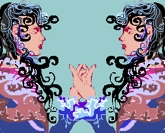Lady on the Web
Be a guest on Miss Gray's Web talk show. Be witty, be wise and beware, for she will quote you! Click Lady on the Web to read her blog. Dr. Stein
Dr. Stein, on sabbatical from Orpheus College, is developing a new form of literary criticism based on chaos theory and classical psychoanalysis. (Note: This is not the famous Jungian Murray Stein.) The MirrorMatch wits with a most reflective character, prepare for free association of ideas. The Mirror quotes Richard Foreman, many guests and you. |
Tuesday, February 21, 2006Java World, Cont'd.
Have studied the weighty Java tome through page 46. To reach page 71 was my assignment. Problems with 1100-pp. book:
-- It's over 1100 pp., thus is daunting in scope. -- It's 2 inches thick, thus is both unwieldy and heavy. -- The type size is around 7 or 8 point, way too small; some of the examples are smaller still, thus well-nigh illegible. -- The column width is too wide and the margins are too small, thus one's eye-tracking is strained. -- A man wrote it. This can be perfectly fine, but in techville, sometimes a woman teacher's angle meshes better with a woman student's mind. -- There is too much math in it already. I must ask my tutor what percentage of Java programming involves math. -- The math in the book is not made digestible for non-math minds. I need to work with colored blocks, games and in other right-brain/intuitive ways. Concrete, not abstract, especially not at the beginning. -- The book is from 1999, which is kind of old in techville. Therefore, I've ILL-requested Java 2 for the World Wide Web, by Dori Smith, pub. 2002. It's only 345 pp., and is part of the excellent Visual Quickstart Guide series. Each page has a narrow column of large, easy-to-read text, next to a column of pictures (generally screenshots). Granted, it may be way too much of a "lite" approach for a serious programming student, but perhaps both books can be used.
Comments:
Thanks for the mention of my Java book! Yes, it's not terribly in-depth, but that's part of what makes it a good starter book for non-programmers.
Post a Comment
The companion site is here, and you can download all the applets and the code from there as well. Best of luck! << Home |
My WebcomicsCircular ReasoningFace2Face Previous Posts
ArchivesSite FeedMy Web SiteWebsafe Studio, founded in 2002, features my visual, verbal and virtual arts. |


